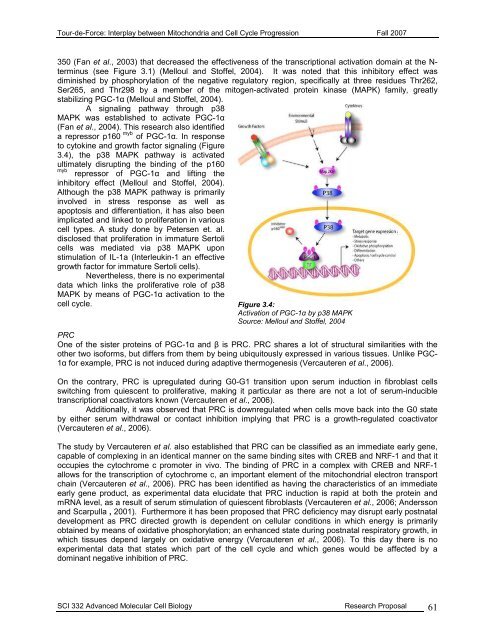Tour-de-Force
Tour-de-Force
Tour-de-Force
You also want an ePaper? Increase the reach of your titles
YUMPU automatically turns print PDFs into web optimized ePapers that Google loves.
<strong>Tour</strong>-<strong>de</strong>-<strong>Force</strong>: Interplay between Mitochondria and Cell Cycle Progression Fall 2007350 (Fan et al., 2003) that <strong>de</strong>creased the effectiveness of the transcriptional activation domain at the N-terminus (see Figure 3.1) (Melloul and Stoffel, 2004). It was noted that this inhibitory effect wasdiminished by phosphorylation of the negative regulatory region, specifically at three residues Thr262,Ser265, and Thr298 by a member of the mitogen-activated protein kinase (MAPK) family, greatlystabilizing PGC-1α (Melloul and Stoffel, 2004).A signaling pathway through p38MAPK was established to activate PGC-1α(Fan et al., 2004). This research also i<strong>de</strong>ntifieda repressor p160 myb of PGC-1α. In responseto cytokine and growth factor signaling (Figure3.4), the p38 MAPK pathway is activatedultimately disrupting the binding of the p160mybrepressor of PGC-1α and lifting theinhibitory effect (Melloul and Stoffel, 2004).Although the p38 MAPK pathway is primarilyinvolved in stress response as well asapoptosis and differentiation, it has also beenimplicated and linked to proliferation in variouscell types. A study done by Petersen et. al.disclosed that proliferation in immature Sertolicells was mediated via p38 MAPK uponstimulation of IL-1a (Interleukin-1 an effectivegrowth factor for immature Sertoli cells).Nevertheless, there is no experimentaldata which links the proliferative role of p38MAPK by means of PGC-1α activation to thecell cycle.Figure 3.4:Activation of PGC-1α by p38 MAPKSource: Melloul and Stoffel, 2004PRCOne of the sister proteins of PGC-1α and β is PRC. PRC shares a lot of structural similarities with theother two isoforms, but differs from them by being ubiquitously expressed in various tissues. Unlike PGC-1α for example, PRC is not induced during adaptive thermogenesis (Vercauteren et al., 2006).On the contrary, PRC is upregulated during G0-G1 transition upon serum induction in fibroblast cellsswitching from quiescent to proliferative, making it particular as there are not a lot of serum-inducibletranscriptional coactivators known (Vercauteren et al., 2006).Additionally, it was observed that PRC is downregulated when cells move back into the G0 stateby either serum withdrawal or contact inhibition implying that PRC is a growth-regulated coactivator(Vercauteren et al., 2006).The study by Vercauteren et al. also established that PRC can be classified as an immediate early gene,capable of complexing in an i<strong>de</strong>ntical manner on the same binding sites with CREB and NRF-1 and that itoccupies the cytochrome c promoter in vivo. The binding of PRC in a complex with CREB and NRF-1allows for the transcription of cytochrome c, an important element of the mitochondrial electron transportchain (Vercauteren et al., 2006). PRC has been i<strong>de</strong>ntified as having the characteristics of an immediateearly gene product, as experimental data elucidate that PRC induction is rapid at both the protein andmRNA level, as a result of serum stimulation of quiescent fibroblasts (Vercauteren et al., 2006; An<strong>de</strong>rssonand Scarpulla , 2001). Furthermore it has been proposed that PRC <strong>de</strong>ficiency may disrupt early postnatal<strong>de</strong>velopment as PRC directed growth is <strong>de</strong>pen<strong>de</strong>nt on cellular conditions in which energy is primarilyobtained by means of oxidative phosphorylation; an enhanced state during postnatal respiratory growth, inwhich tissues <strong>de</strong>pend largely on oxidative energy (Vercauteren et al., 2006). To this day there is noexperimental data that states which part of the cell cycle and which genes would be affected by adominant negative inhibition of PRC.SCI 332 Advanced Molecular Cell Biology Research Proposal 61
















